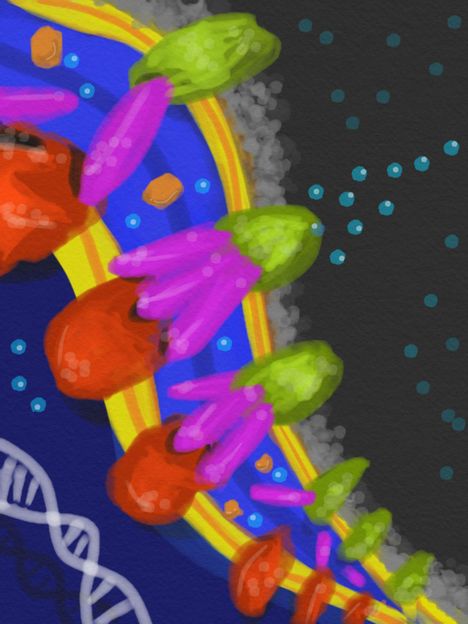Acupuncture's molecular effects pinned down
New insights spur effort to boost treatment's impact significantly
In a paper published in Nature neuroscience, a team at the University of Rochester Medical Center identifies the molecule adenosine as a central player in parlaying some of the effects of acupuncture in the body. Building on that knowledge, scientists were able to triple the beneficial effects of acupuncture in mice by adding a medication approved to treat leukemia in people.
The research focuses on adenosine, a natural compound known for its role in regulating sleep, for its effects on the heart, and for its anti-inflammatory properties. But adenosine also acts as a natural painkiller, becoming active in the skin after an injury to inhibit nerve signals and ease pain in a way similar to lidocaine.
In the current study, scientists found that the chemical is also very active in deeper tissues affected by acupuncture. The Rochester researchers looked at the effects of acupuncture on the peripheral nervous system – the nerves in our body that aren't part of the brain and spinal cord. The research complements a rich, established body of work showing that in the central nervous system, acupuncture creates signals that cause the brain to churn out natural pain-killing endorphins.
The new findings add to the scientific heft underlying acupuncture, said neuroscientist Maiken Nedergaard, M.D., D.M.Sc., who led the research. Her team is presenting the work at a scientific meeting, Purines 2010, in Barcelona, Spain.
"Acupuncture has been a mainstay of medical treatment in certain parts of the world for 4,000 years, but because it has not been understood completely, many people have remained skeptical," said Nedergaard, co-director of the University's Center for Translational Neuromedicine, where the research was conducted.
"In this work, we provide information about one physical mechanism through which acupuncture reduces pain in the body," she added.
To do the experiment, the team performed acupuncture treatments on mice that had discomfort in one paw. The mice each received a 30-minute acupuncture treatment at a well known acupuncture point near the knee, with very fine needles rotated gently every five minutes, much as is done in standard acupuncture treatments with people.
The team made a number of observations regarding adenosine: In mice with normal functioning levels of adenosine, acupuncture reduced discomfort by two-thirds. In special "adenosine receptor knock-out mice" not equipped with the adenosine receptor, acupuncture had no effect. When adenosine was turned on in the tissues, discomfort was reduced even without acupuncture. During and immediately after an acupuncture treatment, the level of adenosine in the tissues near the needles was 24 times greater than before the treatment.
Once scientists recognized adenosine's role, the team explored the effects of a cancer drug called deoxycoformycin, which makes it harder for the tissue to remove adenosine. The compound boosted the effects of acupuncture treatment dramatically, nearly tripling the accumulation of adenosine in the muscles and more than tripling the length of time the treatment was effective.
"It's clear that acupuncture may activate a number of different mechanisms," said Josephine P. Briggs, M.D., director of the National Center for Complementary and Alternative Medicine at the National Institutes of Health. "This carefully performed study identifies adenosine as a new player in the process. It's an interesting contribution to our growing understanding of the complex intervention which is acupuncture," added Briggs, who is the spouse of co-author Jurgen Schnermann.
Most read news
Topics
Organizations
Other news from the department science

Get the life science industry in your inbox
By submitting this form you agree that LUMITOS AG will send you the newsletter(s) selected above by email. Your data will not be passed on to third parties. Your data will be stored and processed in accordance with our data protection regulations. LUMITOS may contact you by email for the purpose of advertising or market and opinion surveys. You can revoke your consent at any time without giving reasons to LUMITOS AG, Ernst-Augustin-Str. 2, 12489 Berlin, Germany or by e-mail at revoke@lumitos.com with effect for the future. In addition, each email contains a link to unsubscribe from the corresponding newsletter.
Most read news
More news from our other portals
Last viewed contents
APEIRON Biologics announces financing round for the further development of the COVID-19 drug APN01 - Financing secures further clinical trials and the supply of material for the treatment of COVID-19 patients
NovogeneAIT Singapore and the Genome Institute of Singapore forge Public-Private Partnership - Establishing whole genome sequencing centre in Singapore
Gene that influences the ability to remember faces
Estación_de_Fotobiología_Playa_Unión

E. coli bacteria's defense secret revealed
Felicitex Therapeutics and Selvita Initiate Strategic Collaboration to Target Cancer Quiescence

Faecal Pollution: DNA Uncovers Culprit - CSI and forensics can be used to uncover not only serial killers but also the cause of water pollution
Chinese_Mental_Health_Association
Catalent Invests $7.3 Million in Italy - Expands Softgel Encapsulation and Packaging Capabilities in Support of Consumer Health





















































